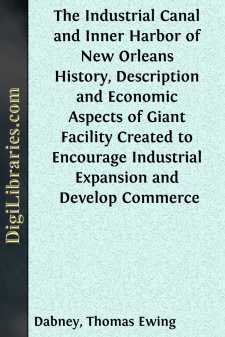Categories
- Antiques & Collectibles 13
- Architecture 36
- Art 48
- Bibles 22
- Biography & Autobiography 813
- Body, Mind & Spirit 142
- Business & Economics 28
- Children's Books 14
- Children's Fiction 11
- Computers 4
- Cooking 94
- Crafts & Hobbies 4
- Drama 346
- Education 46
- Family & Relationships 57
- Fiction 11829
- Games 19
- Gardening 17
- Health & Fitness 34
- History 1377
- House & Home 1
- Humor 147
- Juvenile Fiction 1873
- Juvenile Nonfiction 202
- Language Arts & Disciplines 88
- Law 16
- Literary Collections 686
- Literary Criticism 179
- Mathematics 13
- Medical 41
- Music 40
- Nature 179
- Non-Classifiable 1768
- Performing Arts 7
- Periodicals 1453
- Philosophy 64
- Photography 2
- Poetry 896
- Political Science 203
- Psychology 42
- Reference 154
- Religion 513
- Science 126
- Self-Help 84
- Social Science 81
- Sports & Recreation 34
- Study Aids 3
- Technology & Engineering 59
- Transportation 23
- Travel 463
- True Crime 29
The Industrial Canal and Inner Harbor of New Orleans History, Description and Economic Aspects of Giant Facility Created to Encourage Industrial Expansion and Develop Commerce
Description:
Excerpt
THE NEED RECOGNIZED FOR A CENTURY.
There is a map in the possession of T. P. Thompson of New Orleans, who has a notable collection of books and documents on the early history of this city, dated March 1, 1827, and drawn by Captain W. T. Poussin, topographical engineer, showing the route of a proposed canal to connect the Mississippi River and Lake Pontchartrain, curiously near the site finally chosen for that great enterprise nearly a hundred years later.
New Orleans then was a mere huddle of buildings around Jackson Square; but with the purchase of the Louisiana territory from France, and the great influx of American enterprise that characterized the first quarter of the last century, development was working like yeast, and it was foreseen that New Orleans' future depended largely upon connecting the two waterways mentioned—the river, that drains the commerce of the Mississippi Valley, at our front door, and the lake, with its short-cut to the sea and the commerce of the world, at the back.
When the Carondelet canal, now known as the Old Basin Canal, was begun in 1794, the plan was to extend it to the river. It was also planned to connect the New Basin Canal, begun in 1833, with the Mississippi. This was, in fact, one of the big questions of the period. That the work was not put through was due more to the lack of machinery than of enterprise.
During the rest of the century, the proposal bobbed up at frequent intervals, and the small Lake Borgne canal was finally shoved through from the Mississippi to Lake Borgne, which is a bay of Lake Pontchartrain.
The difference between these early proposals and the plan for the Industrial Canal and Inner Harbor that was finally adopted, is that the purpose in the former case was simply to develop a waterway for handling freight, whereas the object of New Orleans' great facility, now nearing completion, is to create industrial development.
Under the law of Louisiana, inherited from the Spanish and French regimes, river frontage can not be sold or leased to private enterprise. This law prevents port facilities being sewed up by selfish interests and insures a fair deal for all shipping lines, new ones as well as old, with a consequent development of foreign trade; and port officials, at harbors that are under private monopoly, would give a pretty if the Louisiana system could be established there.
But there is no law, however good, that meets all conditions, and a number of private enterprises—warehouses and factories—have undoubtedly been kept out of New Orleans because they could not secure water frontage.
An artificial waterway, capable of indefinite expansion, on whose banks private enterprise could buy or lease, for a long period of time, the land for erecting its buildings and plants, without putting in jeopardy the commercial development of the port; a waterway that would co-ordinate river, rail and maritime facilities most economically, and lend itself to the development of a "free port" when the United States finally adopts that requisite to a world commerce—that was the recognized need of New Orleans when the proposal for connecting the two waterways came to the fore in the opening years of the present century....


